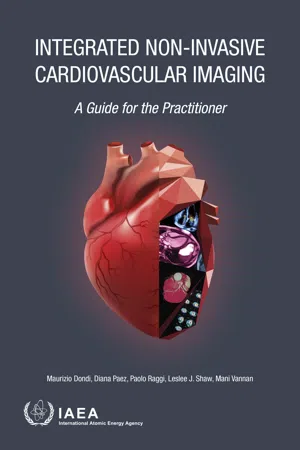Chapter 11
ACUTE CORONARY SYNDROMES
S. DORBALA, G. KARTHIKEYAN, A. PEIX, D. PAEZ, J. VITOLA
Cardiovascular diseases remain a leading cause of mortality. In 2013, they accounted for 17.3 million deaths worldwide [11.1], including over 8 million deaths from coronary heart disease alone [11.2]. Acute chest pain is one of the most common cause of visits to the accident and emergency department; however, only 30% of such acute chest pain visits represent acute coronary syndromes (ACSs) [11.3, 11.4]. ACSs accounted for more than one million hospital discharges in the United States of America alone in 2010, and globally this burden is likely much larger [11.1]. The appropriate evaluation of ACS with early and safe discharge of patients without ACS combined with guideline directed management of ACSs can substantially reduce health care costs and improve clinical outcomes. Imaging plays a key role both in excluding ACSs and in managing and risk stratifying patients with documented ACSs.
11.1. Definition of acute coronary syndrome
ACSs include three distinct pathophysiological entities: (i) unstable angina; (ii) myocardial infarction with ST segment elevation (STEMI); and (iii) myocardial infarction without ST segment elevation (NSTEMI). Unstable angina is defined as angina that is worsening in frequency or severity, occurring at rest or occurring for the first time but which does not result in myocyte necrosis [11.5, 11.6]. Myocardial infarction is diagnosed by a typical rise and fall of cardiac biomarkers (troponins > 99th percentile of the upper reference limit) along with at least one of the following: anginal symptoms, electrocardiogram (ECG) changes, evidence of myocardial scarring (regional wall motion abnormalities on imaging or evidence of loss of myocardial viability) or intracoronary thrombus (on angiography or at autopsy) [11.7]. The pathophysiology of each of these forms of ACS is distinct.
11.2. Pathophysiology of acute coronary syndrome
Plaque instability with or without plaque rupture and thrombus formation is a key triggering event in ACSs [11.8]. Macrophage rich or inflamed plaques, lipid laden plaques and plaques with thin cap fibroatheromas are more prone to rupture [11.9]. Macrophages release enzymes that degrade the extracellular matrix in the arteries and mediate plaque rupture; they also increase the thrombogenicity of the lipid laden plaque [11.9]. However, recent studies indicate that the composition of unstable atherosclerotic plaques has changed substantially over time [11.10]. This is likely at least in part owing to the aggressive primary and secondary prevention of coronary artery disease (CAD) since the 1990s, in particular the increased use of statin therapy for lipid lowering. Present day atherosclerotic plaques demonstrate lower fat content, a smaller inflammatory burden, lower calcium content and a smaller thrombus burden [11.10]. Plaque erosion is an increasingly common cause of ACS (30%) [11.11], and ACS without thrombosis is seen in 20% of patients [11.9]. Vasospasm, epicardial fat inflammation and microvascular disease have been implicated in ACS without thrombosis and in myocardial infarction with non-obstructive coronary arteries (MINOCA) [11.8, 11.9]. Unstable plaques, plaque erosion and plaque rupture result in angina and can progress to myocardial infarction and related complications of heart failure, mechanical complications, arrhythmic events or death. Imaging plays a key role in diagnosing ACS and its complications and in guiding management.
11.3. Role of non-invasive imaging in acute coronary syndrome
The goals of evaluation in ACSs, and thus the choice of techniques used, vary from the acute (during acute chest pain/ACS) to subacute (immediate post-ACS) and chronic phase (late post-ACS) [11.5, 11.6]. During the acute phase, the pre-test risk of ACS based on clinical and ECG evaluation, laboratory and cardiac biomarkers and risk scores for ACS determine the choice of imaging [11.5, 11.6, 11.12, 11.13]. Invasive coronary angiography with ad hoc intravascular imaging, such as optical coherence tomography, intravascular ultrasound and haemodynamic assessment through fractional flow reserve prior to coronary revascularization are common in the evaluation of patients with documented ACS or in those with intermediate to high risk ACS. Non-invasive imaging is often reserved to identify complications, diagnose CAD in intermediate to low probability ACS patients or assess risk post-ACS [11.5, 11.6]. Depending on the clinical question being asked, echocar...
